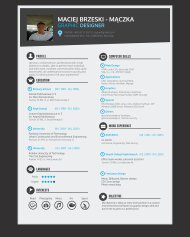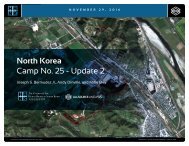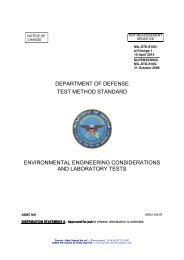ASA_HRNK_Camp12_201608_v10_LR
You also want an ePaper? Increase the reach of your titles
YUMPU automatically turns print PDFs into web optimized ePapers that Google loves.
H R<br />
N K<br />
CH’OMA-BONG KYO-HWA-SO NO. RESTRICTED 12, JŎNGŎ-RI AREA<br />
North Korea: Imagery Analysis of Kyo-hwa-so No. 12, Jŏngŏ-ri<br />
Area 17, Jŏngŏ-ri Rail Station<br />
The camp is connected to the national rail<br />
network via the stations at P’ungsal-li, 4.3<br />
km north of the facility, and the town of<br />
Jŏngŏ-ri, 2.5 km southwest (Figure 27).<br />
Assessment<br />
Observations and analysis derived<br />
from satellite imagery collected by<br />
DigitalGlobe, Airbus Defense and Space,<br />
N<strong>ASA</strong>’s EO-1 from July 12, 2003 through<br />
May 24, 2015, N<strong>ASA</strong>’s Landsat from<br />
May 27, 1976 through June 6, 1984, and<br />
USGS declassified KH-4, combined with<br />
former prisoner statements and other<br />
publicly available information, indicate<br />
that:<br />
The Kyo-hwa-so No. 12 prison facility<br />
was established between 1980 and<br />
1983 and has operated as such since<br />
that time.<br />
The prison was expanded between<br />
February and August 2009 with the<br />
addition of a rectangular walled annex<br />
for female prisoners. By North Korean<br />
standards, Kyo-hwa-so No. 12 is a<br />
small and well-maintained facility as<br />
is indicated by agricultural activity,<br />
mining activity, and maintenance<br />
in and around the camp’s various<br />
facilities.<br />
Prisoners detained at the camp are<br />
engaged in light industrial, agricultural,<br />
mining, and to a lesser degree,<br />
logging activities.<br />
Sometime prior to 2009, the camp’s<br />
population increased as is evidenced<br />
by the construction of an annex for<br />
female prisoners between February<br />
and August 2009.<br />
At the same time, the administrative,<br />
support, and guard populations likely<br />
increased only slightly as is indicated<br />
by only very minor changes to the<br />
housing infrastructure.<br />
The administrative, barracks, housing,<br />
light industrial, and support structures<br />
throughout the camp appear to be<br />
well maintained and in relatively<br />
good repair. Additionally, the grounds<br />
around these structures and the road<br />
network supporting them are well<br />
maintained.<br />
The few livestock facilities within the<br />
camp are well maintained and show<br />
only minor signs of change.<br />
The camp appears to be connected<br />
to the regional electric power grid via<br />
buried high voltage power transmission<br />
cables that run from the town of<br />
Jŏn’gŏ-ri to a substation at the camp’s<br />
mining facility. From here, power is<br />
distributed to various camp buildings<br />
via above ground power lines.<br />
Recommendations<br />
Continued monitoring of Kyo-hwa-so<br />
No. 12 is recommended to develop an<br />
objective baseline understanding of the<br />
camp’s activities, maintain an evidentiary<br />
catalog of physical changes at the facility,<br />
update its status, develop more conclusive<br />
evidence of prisoner population<br />
size, and assist with the identification of<br />
possible human rights abuses.<br />
COPYRIGHT ©ALLSOURCE ANALYSIS, INC. 2016 34




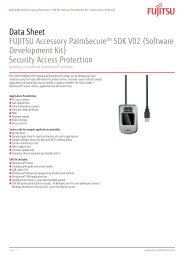
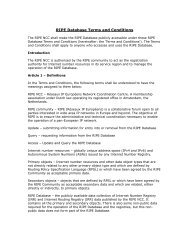

![CV-MBM[186]](https://img.yumpu.com/59137292/1/190x238/cv-mbm186.jpg?quality=85)
